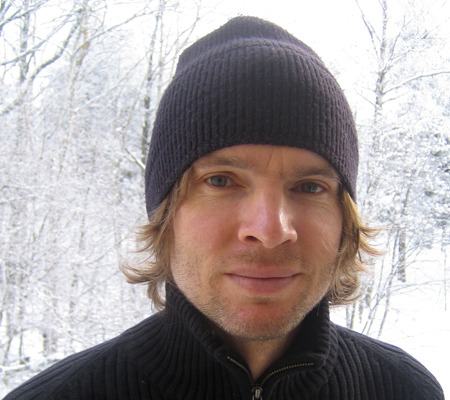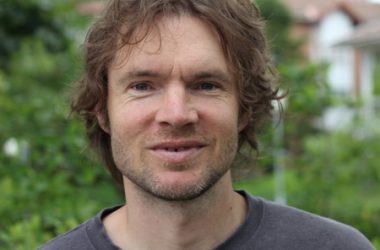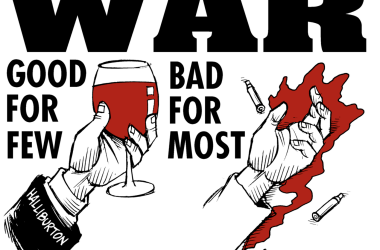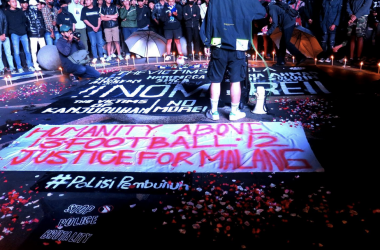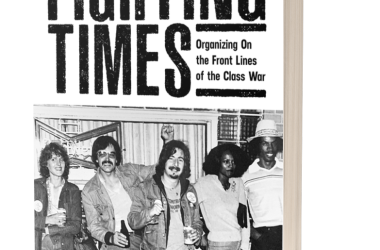By Gabriel Kuhn
A review of Alexander Reid Ross’s Against the Fascist Creep (Chico et al.: AK Press, 2017). Originally published on AAP.
With Grabbing Back: Essays Against the Global Land Grab, a book compiled by Alexander Reid Ross was already published by AK Press in 2014. However, like many of my anarchist peers in Europe, I first took notice of his work when he, together with Joshua Stephens, disclosed the bizarre online antics and confusing politics of the well-known South African anarchist Michael Schmidt in a series of essays titled “About Schmidt: How a White Nationalist Seduced Anarchists Around the World”. While Ross and Stephens need to be lauded for bringing Schmidt’s dubious personality and world view to light, their efforts were tainted by unfortunate circumstances.
First, there was a premature announcement of their revelations that invited unhealthy speculation and polemic from various sides. Second, given the delicate matter at hand, it was not ideal to present the findings in five installments and to blend fact with interpretation and anecdote. Third, the most damaging of the original accusations, namely that Schmidt was “a white nationalist trying to infiltrate the anarchist movement” (rather than an anarchist with unacknowledged right-wing and white nationalist sympathies), was never substantiated. (Anyone who thinks that this difference is merely semantic gravely underestimates the significance it has for political organizing, the security of our movements, and a proper understanding of Michael Schmidt and similar types.) Because of this, I was admittedly a tad apprehensive when I collected my copy of Against the Fascist Creep.
Luckily, any concerns I might have had soon disappeared. In the context of the given volume, Ross’s journalistic approach works well and makes for an engaging read. He explains the title thus:
“The ‘fascist creep,’ as I am using the term in this text, refers to the porous borders between fascism and the radical right, through which fascism is able to ‘creep’ into mainstream discourse. However, the ‘fascist creep’ is also a double-edged term, because it refers more specifically to the crossover space between right and left that engenders fascism in the first place. Hence, fascism creeps in two ways: (1) it draws left-wing notions of solidarity and liberation into ultranationalist, right-wing ideology; and (2), at least in its early stages, fascists often utilize ‘broad front’ strategies, proposing a mass-based, nationalist platform to gain access to mainstream political audiences and key administrative positions.” (p. 3)
The book, in fact, delivers more than what this explanation promises. While Ross does pay particular attention to the intersections of the right and the left, large parts simply constitute a very useful and accessible history of fascist ideology and fascist movements.
*
Ross starts out with the origins of fascism in early-twentieth-century Europe, traces spiritual and ecological influences on its development, explains post-World-War-II phenomena such as the so-called Third Position, and addresses the evolvement of the New Right, peculiar currents such as “autonomous nationalism” and “national anarchism”, and, not least, the currently omnipresent “Alt-Right”.
Ross’s coverage switches regularly from one side of the Atlantic to the other, outlining fascist trends both in Europe and North America. Some European countries receive perhaps less attention than what the significance of their fascist movements might suggest (say, Sweden), and some recent tendencies are not covered at all (such as the “Identitarian” movement), but these are small concerns and omissions are unavoidable in publications tackling a subject matter as broad as this one.
An interesting question, however, is whether Ross’s discussion of fascism should have been extended beyond the borders of Europe and North America. Fascism can be defined as intrinsically bound to white and white settler nations, but Ross never makes that argument. On one occasion, he says that ISIS’s ideology and practice suggests “a kind of fascist cult arising in Southwest Asia” (p. 269), but he does not elaborate on this. Needless to say, it does not take away anything from the analysis of the fascist movements that Ross does consider in his study, but it leaves an open question.
*
As far as the accuracy of historical representation is concerned, I can only comment on the sections I actually feel comfortable commenting on, that is, the ones on the German-speaking countries and Scandinavia.
There are a few minor details that aren’t entirely accurate: unlike Gustav Landauer, the Bavarian communist leader Eugen Leviné was not a victim of “summary executions” after the Bavarian Council Republic had been crushed in 1919, instead he was put on trial and executed two months later (p. 48;); the Red Ruhr Army might have established a form of dual power during the 1920 uprising in the region, but, unfortunately, was not able “putting the government … under worker control” (p. 51); the term Querfront has always referred to the attempt of aligning radical forces of both the right and the left, not “to bring conservatives and reactionaries together in a coalition government” (p. 60); there was not a single “new group” that was formed in Germany in the 1980s, “drawing on the name and legacy of one of the militant left-wing interwar groups, Antifaschistische Aktion (AFA)”, but numerous independent projects and initiatives using that label (p. 143); likewise, in the 1990s, there was no centralized right-wing organization called Freie Kameradschaft that “quickly generated a web of some 150 regional and supra-regional groups throughout Germany”, but plenty of independent right-wing groups using that tag, copying left-wing forms of autonomous organizing (p. 167); finally, Anders Behring Breivik did not kill “eighteen people with a car bomb” before slaughtering 69 members of the Social Democrats’ youth federation at their summer camp, since the actual death toll of the bomb detonated in Oslo’s government quarters was eight (p. 265).
The fact that this list consists of things so petty that no one except nerds like myself care about them confirms that Ross’s overall account is very solid. Most importantly, he manages to weave plenty of information into a narrative that is highly readable. This is a remarkable achievement as a writer and one of the strongest aspects of the book.
*
I take no issue with Ross’s definition of fascism, although it marks one of the book’s not so readable passages:
“In short, fascism is a syncretic form of ultranationalist ideology developed through patriarchal mythopoesis, which seeks the destruction of the modern world and the spiritual palingenesis (‘rebirth’) of an organic community led by natural elites through the fusion of technological advancement and cultural tradition.” (p. 7)
There are different ways to define fascism and, in a general overview such as the one presented by Ross, the important thing is to stick to the framework that one has staked out. I believe that Ross does so. The only qualm I have is that he – at times lightheartedly, it seems – associates certain people and movements with the term who have an ambiguous relationship with fascism at best.
I am not particularly concerned about historical figures such as Max Stirner and Friedrich Nietzsche, although I see their political legacy less clearly tied to the right than Ross seems to do. What troubles me more are offhand remarks such as the following: “…the post-structuralist writings of Georges Bataille, Michel Foucault, and Jean-Francois Lyotard mingled with right-wing elitism and the critique of consumerism to forge a new balance between authoritarianism and an imagined, liberating future” (p. 166). Whatever use some folks may have made of the mentioned authors’ work, all three of them were lifelong antifascist militants. Not to mention this when referencing the minor influence their work might have had on the right is misleading and unfair.
*
Another question I asked myself while reading Ross’s book was what its implications were regarding the contact between the left and the right in general. Is any engagement by leftists with right-wing forces an indication for fascism creeping into their ranks? If that was the case, what does this mean for anarchist luminaries such as Erich Mühsam and Rudolf Rocker who, in the early 1930s, held public meetings with representatives of the National Socialists’ “left wing” (the so-called Strasser current, documented in Ross’s book)? The events were co-organized with the intention to “get to know and understand each other through sensible discussion”, as explained in Mühsam’s journal Fanal under the header “A Worthwhile Attempt”. Does this mean the anarchists were seduced by fascists? Did they have fascist sympathies? Did they believe they could bring the right-wingers over to their side? Or did they think that an open debate was important to convince working-class folks to rally around the ideals of solidarity rather than chauvinism? These are difficult questions to answer, but they indicate that antifascism is more complicated than denouncing fascists and celebrating one’s own righteousness. (No message conveyed by Ross’s book, I’m just making a general point here.) Revolutionary politics are often conducted in muddy waters, but it is the environment we are forced to move in if we want to change anything. Despite all the risks and dangers this implies, we need to figure out when and how to engage with opponents rather than to withdraw from the political terrain altogether and settle for the moral high ground. This would be fatal.
Ross states in his conclusion that the main opposition to today’s “neoliberal deregulation” comes from “a movement that fuses the radical left and right” (p. 329). Maybe that’s correct. But the answer is not to embrace neoliberalism as the last line of defense against fascism, as an increasing number of folks on both sides of the Atlantic do, leftists included. (There is no indication that Ross would be one of them.) Ross is right in pointing out that “education” and “the ethic of cooperation and mutual aid” are needed in combating authoritarianism (p. 330-331). But the question is whether this will be enough. The answer will be given by the working-class movements organizing against it.
Against the Fascist Creep is a great book for understanding fascism and for appreciating the dangers of being drawn into it without noticing. With it, Ross has established himself as an important analyst of the far right, along the likes of Matthew N. Lyons, who contributes regularly to the blog Three Way Fight and whose recent essay “Ctrl-Alt-Delete: An Antifascist Report on the Alternative Right” I highly recommend as additional reading! Gabriel Kuhn
(August 2017)
More blogs from Gabriel | Back to Gabriel Kuhn’s Author Page

